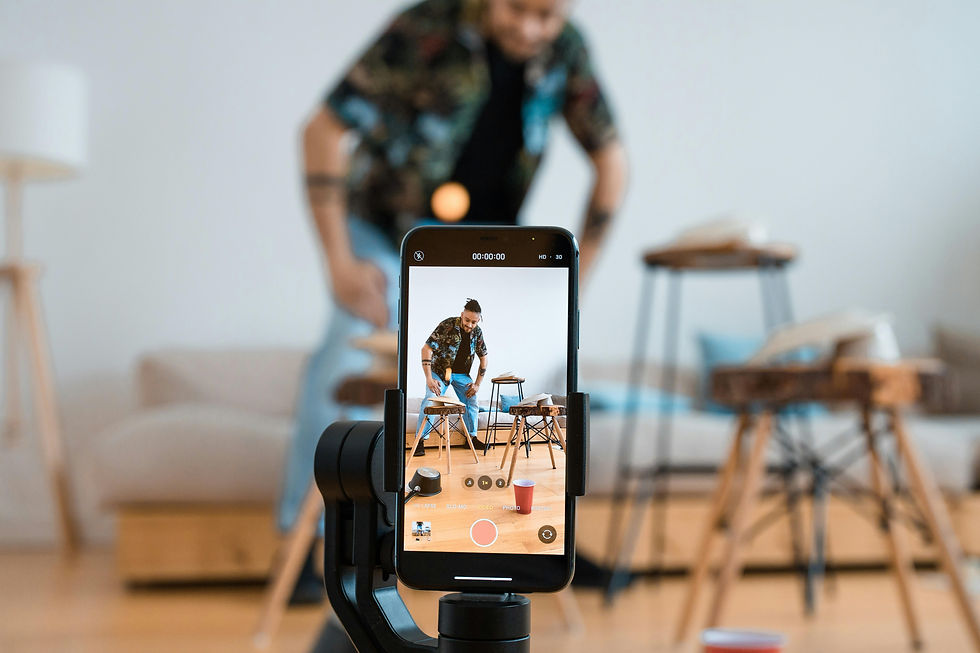How to Launch Your First Influencer Marketing Campaign in 7 Steps
- Adam Mohammed

- Sep 5, 2024
- 4 min read
Launching your first influencer marketing campaign? Learn how to leverage influencers to grow your brand, from setting goals to measuring results, in this comprehensive guide.
Summary:
Define Your Goals
Know Your Audience
Choose the Right Influencer
Plan Your Campaign
Set Your Budget
Launch and Engage
Measure Results
Introduction
In today’s fast-paced digital world, influencer marketing has become one of the most powerful ways to grow a business. Whether you’re a small business or a startup, partnering with influencers allows you to tap into an engaged audience, building brand awareness and driving sales in an authentic way. In this post, we’ll walk you through launching your first influencer marketing campaign, step by step. By the end, you'll have everything you need to get started and scale up your efforts.

Understanding Influencer Marketing
What is Influencer Marketing? Influencer marketing is the process of promoting your brand through someone else's platform—typically an individual with a large, engaged audience usually on social media (but this can come in other forms such as Blogs or even big email lists). By leveraging the trust that influencers have built with their followers, businesses can reach their target market more effectively.
Benefits of Influencer Marketing For small businesses, influencer marketing can lead to increased brand exposure, higher engagement rates, and more conversions. According to a study by the Digital Marketing Institute, 49% of consumers rely on influencer recommendations to make purchase decisions. Having an influencer promote your can bring quality traffic that to your brand and can be available for a variety of budgets.
Types of Influencers
Nano-influencers: 1K-10K followers (highly niche audience, strong personal connection).
Micro-influencers: 10K-100K followers (good engagement rates, affordable).
Macro-influencers: 100K-1M followers (wider reach, less personal).
Mega-influencers: 1M+ followers (huge reach but may lack audience specificity).

Step 1: Define Your Goals
Before starting, identify what you want to achieve. Are you aiming for brand awareness like growing your social media or email list, increase sales, or perhaps to promote a new product?
Set SMART Goals (Specific, Measurable, Achievable, Relevant, Time-bound):
For example, "I want to increase my Instagram followers by 20% in the next three months" is a clear and measurable goal. Setting SMART goals can help you structure your approach to a successful campaign.
Step 2: Know Your Audience
Understanding who your target audience is will help you select the right influencer and craft messages that resonate well, creating a strong flow of traffic to your brand.
Audience Analysis: Use tools like Google Analytics, Facebook Insights or a simple customer survey to gather demographic data about your audience.
Align Influencers with Audience: Ensure that the influencer’s followers match your ideal customer profile in terms of age, location, and interests. This would be a good chance to look at your brands buyer persona and there hobbies or media habits.
Step 3: Choose the Right Influencer
Choosing the right influencer can really determine the success your campaign and the reputation of your brand. Look beyond follower count and focus on:
Engagement Rates: How often do followers interact with the influencer’s content?
Content Quality: Does their content align with your brand’s voice and values?
Relevance: Is their audience your ideal customer?
Pro Tip: Tools like AspireIQ and Upfluence can help you find influencers based on niche, location, and audience metrics.

Step 4: Plan Your Campaign
Now that you’ve identified your goals and chosen your influencer, it’s time to plan your campaign.
Campaign Brief: Provide the influencer with a detailed brief, outlining your campaign’s goals, key messages, and deliverables. Be clear on the tone, style, and required content (e.g., video, images, stories).
Content Guidelines: Ensure consistency in messaging while leaving room for the influencer’s creativity.
Timeline: Set clear deadlines and milestones to ensure smooth coordination.
Step 5: Set Your Budget
When planning your budget, keep in mind that influencer rates can vary greatly. Allocate your budget not only for the influencer’s fee but also for content production and any paid amplification (e.g., boosting posts).
Negotiating Fees: Remember, influencers may be open to negotiation, especially if you can offer additional perks, such as free products or affiliate commissions.
Incentives: Consider offering performance-based incentives to encourage the influencer to drive more sales or engagement.
Step 6: Launch the Campaign
Once the groundwork is laid, it’s time to launch!
Coordinate with Influencers: Ensure everyone is aligned on the launch date and content deliverables.
Engagement: Actively engage with the influencer's audience. Reply to comments, repost content, and show your presence to build stronger connections with potential customers.

Step 7: Measure Results
Now it’s time to evaluate your campaign’s success.
Track Performance: Use analytics tools like Google Analytics, Instagram Insights, or the influencer's metrics to measure key performance indicators (KPIs) such as engagement rates, website traffic, or sales.
Analyze ROI: Track how much revenue was generated against the amount spent on the campaign. According to a survey by Mediakix, businesses are making an average of $5.20 for every $1 spent on influencer marketing.
Conclusion: Take Action Now with AMUK Media
Influencer marketing offers immense potential for small businesses, and with the right strategy, it can lead to incredible growth. Start by defining your goals, selecting the right influencer, and crafting a campaign that speaks to your audience. Remember to track your results and continuously refine your strategy.
CTA: Need help launching your first influencer campaign? Contact AMUK Media today, and let’s turn your marketing goals into reality!




Comments